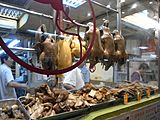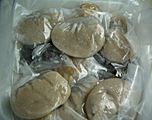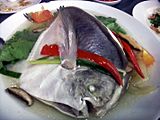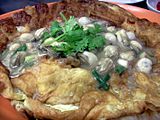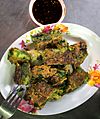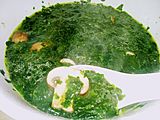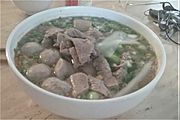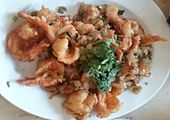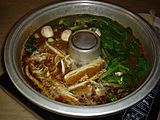Teochew cuisine facts for kids
Quick facts for kids Teo-Swa cuisine |
|||||||||||||||
|---|---|---|---|---|---|---|---|---|---|---|---|---|---|---|---|
| Chinese | 潮汕菜 | ||||||||||||||
|
|||||||||||||||
| Chaoshan cuisine | |||||||||||||||
| Chinese | 潮汕菜 | ||||||||||||||
|
|||||||||||||||
Chaoshan cuisine, also known as Chiuchow cuisine or Teo-swa cuisine, comes from the Chaoshan area in eastern Guangdong Province, China. This region includes the cities of Chaozhou, Shantou, and Jieyang. Chaoshan food is quite similar to Fujian cuisine, especially Southern Min dishes. This is because the cultures, languages, and locations of Chaoshan and Fujian are very close. However, Chaoshan cooking also uses styles and methods from Cantonese cuisine.
Contents
What Makes Chaoshan Cuisine Special?
Chaoshan food is famous for its fresh seafood and vegetarian dishes. Chefs here use fewer strong flavors than in many other Chinese cuisines. The taste mostly comes from how fresh and good the ingredients are. This is a delicate type of cooking. They don't use a lot of oil. Instead, they focus on cooking methods like poaching (gently cooking in liquid), steaming, and braising (slow cooking in liquid). Stir frying is also common.
Chaoshan cuisine is also known for serving congee (a type of rice porridge called mue). This is often eaten with steamed rice or noodles. The Chaoshan mue is very watery, with rice grains loosely sitting at the bottom. This is different from Cantonese congee, which is a thicker porridge.
Tea Time!
Real Chaoshan restaurants serve a very strong oolong tea called Tieguanyin. They serve it in tiny cups before and after the meal. This tea is part of a special way of serving called gongfu tea. It has a thick, bittersweet taste, which people call gam gam.
Special Sauces
A popular sauce in Fujian and Taiwanese cuisine is shacha sauce. It's often linked to some Chaoshan groups. This sauce is made from soybean oil, garlic, small onions, chilies, brill fish, and dried shrimp. It tastes savory and a little spicy. You can use it in many ways: as a soup base, a rub for grilled meats, a seasoning for stir-fries, or a dipping sauce.
Besides soy sauce, which is used in all Chinese cooking, Chaoshan people living in Southeast Asia use fish sauce. It adds flavor to soups and sometimes works as a dipping sauce, like for Vietnamese spring rolls.
The Secret Broth
Chaoshan chefs often use a special soup base called superior broth. This broth stays on the stove and is always being refilled. Some chefs in Hong Kong are even said to use the same superior broth for decades! You can also see this special stock on Chaozhou TV cooking shows.
Big Feasts
There's a famous Chaoshan feast called jiat dot (meaning "food table"). Many dishes are served at this feast. These can include shark fin soup, bird's nest soup, lobster, steamed fish, roasted suckling pig, and braised goose.
Chaoshan chefs are proud of their amazing vegetable carving skills. They use carved vegetables to decorate cold dishes and the banquet table.
Late-Night Snacks
Chaoshan cuisine is also known for a late-night meal called meh siao or daa laang. Chaoshan people love to eat out close to midnight. They go to restaurants or roadside food stalls. Some places, like dai pai dong (open-air food stalls), stay open until morning.
Unlike many other Chinese restaurants, Chaoshan restaurants often have a special section just for desserts on their menus.
Chaoshan People Around the World
Many people from Chaoshan, also known as Teochiu or Chaoshan people, have moved to places like Hong Kong and Southeast Asia. You can find them in Malaysia, Singapore, Cambodia, and Thailand. Their cooking styles have influenced Singaporean cuisine and other local foods. A lot of Chaoshan people have also settled in Taiwan, and their influence is clear in Taiwanese cuisine. Other Chaoshan communities are in Vietnam, Cambodia, and France. A popular noodle soup in Vietnam and Cambodia, called hu tieu, actually came from Chaoshan. There's also a big group of Chaoshan people in the United States, especially in California. In Paris, France, there's a Teochew Chinese Association.
Famous Dishes
| English | Traditional Chinese | Simplified Chinese | Pinyin | Chaoshan Name | What it is |
|---|---|---|---|---|---|
| Bak chor mee | 肉碎麵 | 肉碎面 | ròusuì miàn | bak chor mee | Boiled noodles, dried and mixed with sauces like soy sauce, chili, and lard. Topped with vegetables, minced pork, mushrooms, and fish balls or fishcakes. |
| Bak kut teh | 肉骨茶 | 肉骨茶 | ròugǔchá | bak kut teh | A hearty soup with meaty pork ribs in a rich broth of herbs and spices. It's boiled for hours with pork bones. Often eaten with rice or noodles. |
| Braised dishes | 滷味 | 卤味 | lǔwèi | lo bah | Chaoshan cuisine is known for many braised dishes. These include geese, duck, pork, bean curd, and offal (organ meats). |
| Chai tau kueh | 菜頭粿 | 菜头粿 | càitóu guǒ | chai tau kueh | A savory fried cake made from white radish and rice flour. It's stir-fried with soy sauce, eggs, garlic, and sometimes dried shrimp. |
| Sichuan pepper chicken | 川椒雞 | 川椒鸡 | chuān jiāo jī | cuêng ziê goi | A deep-fried chicken dish, usually served with leafy greens. Basil or spinach can be used outside China. |
| Chwee kueh | 水粿 | 水粿 | shuǐguǒ | chwee kueh | Cup-shaped steamed rice cakes topped with chopped preserved radish. |
| Crystal balls | 水晶包 | 水晶包 | shuǐjīng bāo | zhui jia bao | A steamed dessert with fillings like yellow milk custard, yam paste, or bean paste. They are similar to mochi. |
| Fish balls / fishcakes / fish dumplings | 魚丸 / 魚粿 / 魚餃 | 鱼丸 / 鱼粿 / 鱼饺 | yúwán / yúguǒ / yújiǎo | her ee / her kueh / her kiaw | Fish paste shaped into balls, cakes, and dumplings. Often served in Teochew-style noodles and soups. |
| Flavored-potted goose | 滷水鵝 | 卤水鹅 | lǔ shuǐ é | lou zui gho | A well-known braised goose dish, often served with tofu. |
| Fried bean curd | 炸豆腐 | 炸豆腐 | zhà dòufu | za dao hu | Simple deep-fried tofu slices served with a salted water dip. Some people now use an air fryer for a healthier version. |
| Fried beef balls | 炸牛肉丸 | 炸牛肉丸 | zhà niúròu wán | za ghu bak ee | A simple deep-fried beef ball dish served with dipping sauce like shacha sauce or salted water. Can also be made in an air fryer. |
| Fish ball noodle soup | 魚丸麵 | 鱼丸面 | yúwán miàn | her ee mee | Noodles served in a light fish-flavored broth or dry. Comes with fishballs, fishcakes, and vegetables. |
| Fun guo | 粉粿 | 粉粿 | fěnguǒ | hung gue | A type of steamed dumpling. It's usually filled with dried radish, garlic chives, pork, dried shrimp, mushrooms, and peanuts. |
| Head mustard with mushrooms | 厚菇大芥菜 | 厚菇大芥菜 | hòugū dà jiècài | gao gou dua gai cai | A soup with Chinese mustard and shiitake mushrooms. It was originally vegetarian but often includes diced pork belly now. |
| Kway chap | 粿汁 | 粿汁 | guǒzhī | kueh chap | Flat rice sheets in a dark soy sauce soup. Served with pig offal, braised duck, bean curd, and hard-boiled eggs. |
| Mee pok | 麵薄 | 面薄 | miànbáo | mee pok | A popular noodle dish with minced pork, braised mushrooms, fishballs, dumplings, and sauce. |
| Oolong tea | 烏龍茶 | 乌龙茶 | wūlóng chá | Ou-leeng teh | Tieguanyin is a popular Teochew tea. However, Teochew people often prefer their own hong wang dan cong teh oolong tea. |
| Oyster omelette | 蠔烙 | 蠔烙 | háolào | or lua | An omelette cooked with fresh oysters, tapioca starch, and eggs. Teochew-style is usually deep-fried and very crispy. |
| Pan-fried marinated fish | 烳醃魚 | 烳腌鱼 | pǔyānyú | pu iem he | A pan-fried dish of marinated fish, often using a larimichthys crocea or other types of bass. |
| Patriotic soup (Protect the Country Dish) | 護國菜 | 护国菜 | hùguó cài | hu gog chai | This soup was created during a war and named by the last emperor of the Song Dynasty. It's a simple soup with stir-fried leaf vegetables (like sweet potato leaves or spinach) and edible mushrooms in a broth. |
| Pig's organ soup | 豬雜湯 | 猪杂汤 | zhūzátāng | ter zap terng | A soup made with various pig organs. |
| Popiah | 薄餅仔 | 薄饼仔 | báobǐngzǎi | po piah | A fresh (not fried) spring roll, often eaten during the Qingming Festival. It has a soft, thin wrapper made from wheat flour. The filling is usually finely grated turnip, cooked with other ingredients like bean sprouts, carrots, and tofu. |
| Pork jelly | 豬腳凍 | 猪脚冻 | zhūjiǎo dòng | ter ka dang | Braised pig's leg made into a jelly, sliced, and served cold. |
| Prawns sautéed with olive vegetables | 欖菜焗蝦 | 榄菜焗虾 | lǎncàijúxiā | lam cai ju he | A dish of deep-fried prawns. |
| Red peach cake | 红桃粿 | ng tao guoo | ung toh kway | Pink rice flour skin wrapped around flavorful glutinous rice. It's pressed into a peach shape, then steamed. You can eat it fresh or pan-fried. | |
| Salted vegetable duck soup | 鹹菜鴨湯 | 咸菜鸭汤 | xiáncài yātāng | kiam cai ak terng | A soup with duck, preserved salted vegetables, tomatoes, and preserved sour plums. |
| Spring rolls with prawn or minced meat fillings | 蝦卷 / 燒卷 / 五香 | 虾卷 / 烧卷 / 五香 | xiājuǎn / shāojuǎn / wǔxiāng | heh gerng / sio gerng / ngo hiang | Mixed pork and prawn paste, seasoned with five-spice powder, wrapped in bean curd skin, and deep-fried or pan-fried. |
| Steamed chives dumplings | 韭菜餜 | 韭菜馃 | jiǔ cài guǒ | gu chai gue | These dumplings are sometimes sautéed to make them crispy. |
| Steamed goose | 炊鵝 | 炊鹅 | chuī é | chue gho | A dish of steamed goose. |
| Taro paste | 芋泥 | 芋泥 | yùní | orh ni / orh nee | A traditional Teochew dessert made from steamed and mashed taro. Pumpkin is added for sweetness. It's often served with ginkgo nuts. |
| Teochew chicken | 潮州雞 | 潮州鸡 | Cháozhōu jī | Teochew koi | A dish of sliced chicken. |
| Teochew cold crab | 潮州凍蟹 | 潮州冻蟹 | Cháozhōu dòngxiè | Teochew ngang hoi | A whole crab that is steamed and then served chilled. |
| Teochew hot pot / Teochew steamboat | 潮州火鍋 | 潮州火锅 | Cháozhōu huǒguō | Teochew zuang lou | A dish where fresh, thin ingredients are cooked in a simmering broth right at the table. You then dip them in sauces. |
| Teochew rice noodle soup | 潮州粿條 | 潮州粿条 | Cháozhōu guǒtiáo | Teochew kuay teow | A classic Teochew noodle soup, also popular in Vietnam and Cambodia. It has yellow egg noodles and thin rice noodles in a light, flavorful soup with meatballs, seafood, and vegetables. |
| Teochew-style congee | 潮州糜 | 潮州糜 | Cháozhōu zhōu | Teochew mue | A rice soup that is more watery than Cantonese congee. It's usually served with salty side dishes like preserved vegetables or salted duck eggs. |
| Teochew-style steamed pomfret | 潮州蒸鯧魚 | 潮州蒸鲳鱼 | Cháozhōu zhēng chāngyú | Teochew chue chioh her | Silver pomfret fish steamed with preserved salted vegetables, lard, and sour plums. |
| Yusheng | 魚生 | 鱼生 | yúshēng | her sae | A raw fish salad. It's usually eaten as a starter to bring good luck for the new year, often on the seventh day of the Lunar New Year. |
Images for kids
-
Oyster omelette (蚝烙)


